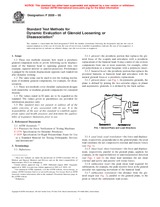We need your consent to use the individual data so that you can see information about your interests, among other things. Click "OK" to give your consent.
ASTM F2028-05
Standard Test Methods for Dynamic Evaluation of Glenoid Loosening or Disassociation
STANDARD published on 1.8.2005
The information about the standard:
Designation standards: ASTM F2028-05
Note: WITHDRAWN
Publication date standards: 1.8.2005
SKU: NS-52507
The number of pages: 6
Approximate weight : 18 g (0.04 lbs)
Country: American technical standard
Category: Technical standards ASTM
Annotation of standard text ASTM F2028-05 :
Keywords:
arthroplasty, glenoid, loosening, subluxation, total shoulder replacement, arthroplasty, disassociation, glenoid, subluxation, total shoulder replacement, ICS Number Code 11.040.40 (Implants for surgery, prothetics and orthotics)
Additional information
| Significance and Use | ||||||
|
This test method is intended to investigate the resistance of a glenoid component to loosening. Glenoid loosening is the most common clinical complication in total shoulder arthroplasty (see X1.1). The method assumes that loosening occurs because of edge loading, often called the rocking-horse phenomenon. This test method can be used both to detect potential problems and to compare design features. Factors affecting loosening performance include articular geometry, flange geometry, materials, fixation design, bone quality, and surgical technique. |
||||||
| 1. Scope | ||||||
|
1.1 These test methods measure how much a prosthetic glenoid component rocks or pivots following cyclic displacement of the humeral head to opposing glenoid rims (for example, superior-inferior or anterior-posterior). Performance is judged by the tensile displacement opposite each loaded rim after dynamic rocking. 1.2 The same setup can be used to test the locking mechanism of modular glenoid components, for example, for disassociation. 1.3 These test methods cover shoulder replacement designs with monolithic or modular glenoid components for cemented fixation. 1.4 The values stated in SI units are to be regarded as the standard. The values given in parentheses are provided for information purposes only. 1.5 This standard does not purport to address all of the safety concerns, if any, associated with its use. It is the responsibility of the user of this standard to establish appropriate safety and health practices and determine the applicability of regulatory limitations prior to use. |
||||||
| 2. Referenced Documents | ||||||
|
We recommend:
Technical standards updating
Do you want to make sure you use only the valid technical standards?
We can offer you a solution which will provide you a monthly overview concerning the updating of standards which you use.
Would you like to know more? Look at this page.




 Cookies
Cookies
